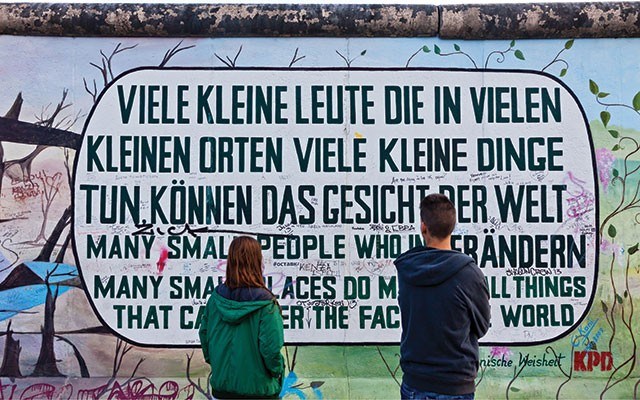In Germany's capital today, sections of the iconic Berlin Wall still stand, though some of the solemn grey wall is now a canvas for graffiti — some soulful, some irreverent.People can straddle each side of what was once a stern barrier dividing part of the "free world" from political tyranny. Visiting this structure was just one reminder on a recent EURODAM Baltic cruise of the resiliency and fragility of the freedom to travel — one of the privileges to celebrate this Remembrance Day week.
This Nov. 9 marks the 25th anniversary of the demise of that imprisoning wall of the Cold War. Two days later on Remembrance Day, November 11, those who fought and who defended freedom on multiple fronts will be remembered — an honour dating back to World War I, when hostilities ended on the eleventh hour, of the eleventh day, of the eleventh month of 1918.
My Berlin guide explained that in August, 1961 the Berlin wall was erected overnight around the Western sector of Berlin. Without warning, East Germans were blockaded — not allowed to travel, work, or visit people living in the British, American, or French sectors of the Berlin divided by the allies of World War II. Overnight, East Germans were prisoners in their own country, cut off from the west.
Today "Checkpoint Charlie," once a major portal for westerners who had permission to go in and out of East Germany, is a reconstructed photo op, with the golden arches of McDonald's in the background.
The grander and more elegant arches of the Brandenburg Gate in Berlin were a closed portal in the Cold War, but now welcome camera-carrying tourists from all over — royalty originally commissioned this historic passageway at the end of the 18th century as a triumphal arch symbolizing peace. The enormous adjoining plaza, the Pariser Platz, is today flanked by upscale stores, the U.S. and French Embassies, an Academy of Arts, and a Kennedy Museum. The large, open, public space buzzes with artists, commerce, and tourists.
Our excursion to this lively, culture-rich, tourist-friendly city began when my husband and I disembarked from our cruise in Warnemunde, Germany. Berlin, a three-hour train ride away, was one of the ship's many excursion offerings.
I was grateful now to be visiting this "unified" Berlin, abundant with café life, centuries of architecture, engaging museums, and international creative vibes. Several times we walked over a line of different coloured cobblestones that marked where the Berlin Wall had once stood. Even the manhole covers at our feet symbolized a united Berlin. The manhole's circle of Berlin landmarks included those from the former East Berlin (including the Television tower) and former West Berlin (including the Remembrance Church) as well as the Chancellery for all Germany, now billed as the largest government building in the world.
There were also poignant, vivid reminders in the Berlin of today from the dark lessons of the past — a field with over 1,000 crosses that represent the people lost as a result of the East German border oppression and the "Memorial to the Murdered Jews," with its more than 2,700 tomb-like concrete slabs that recall the horrors of the holocaust. As you walk there are sometimes "stumblestones" on the ground, plaques of where Jews formerly lived, before being abducted by the Nazis. The stumblestone, or Stolpersteine markers by artist Gunter Demnig's, are a nationwide project by the artist who wants his country to remember its past. There are now more than 27,000 of them across the country.
Back on the train, a delightful young German woman who had spent years in North America studying English guided us. She was part of what my husband called the "Freedom Generation" — her parents had been trapped in East Germany, unable to travel before the Wall fell.
Seeing the changes that have emerged in Berlin since WWII, and the fall of the Berlin Wall, one can only hope warily that "never again" will be about all of humanity's hatred and war and tyranny.
The costs of achieving and maintaining the freedoms of travel, speech, and thought have been paid for dearly — again, and again, and again — and we reap the dividends every time we head out to explore the world.
Holland America's Baltic cruises include ports in Estonia, Finland, Russia, Germany, Denmark and Sweden. www.hollandamerica.com.
(Part II of the Greek Isle travel feature will run in Pique Nov.13, 2014)




